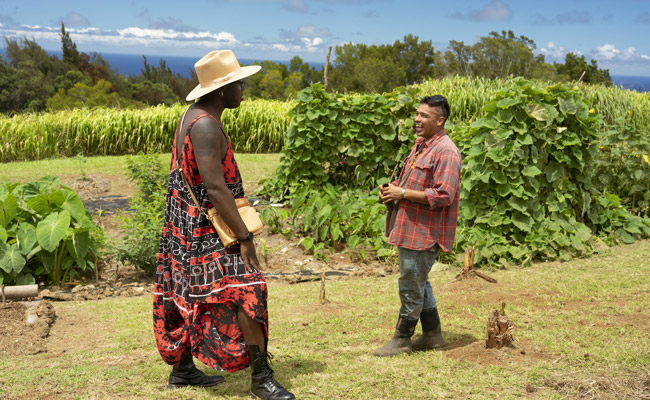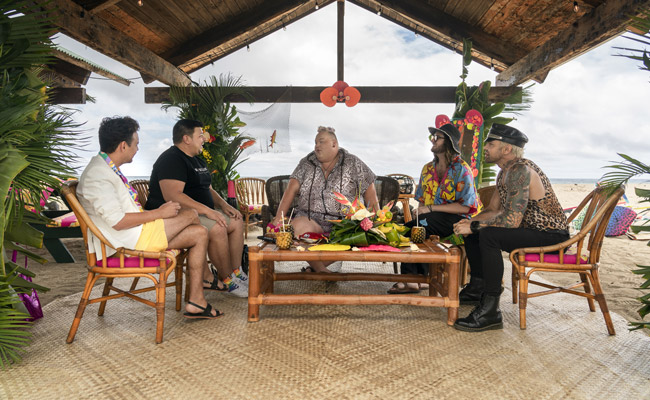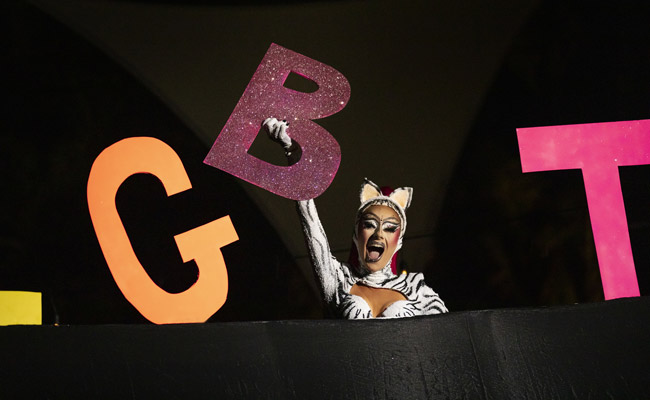
HBO
The penultimate episode of Season 2 of We’re Here goes on a spiritual journey this week as the Queens head to Kona, Hawaii, emerging from the ocean like kaiju to storm the land. Leaving the mainland of the US for Hawaii puts Bob the Drag Queen, Shangela and Eureka into a very different culture but it also shares some similarities with the Indigenous culture they experienced back in Season 1 Episode 4 – Farmington, New Mexico. As in traditional Indigenous culture where the ‘two spirit’ people were often revered, the ancient Hawaiian culture had the ‘Māhū’ (hilariously misspoken by Eureka as ‘Moo-ha’), and bringing that tradition back to a more modern culture is at the forefront of this week’s episode.
Kekoa
Eureka is working with Kekoa this week, a gay man who is no stranger to the world of drag. Kekoa actually performed in drag for several years but those years were a very rough time for him, consumed by addiction and becoming homeless at one point for several years. Kekoa admits that he’s never performed while sober, and now that he has been sober for six years it’s time to dust off those heels and step back into the spotlight with Eureka and the Glam Squad’s help.
Jaquelynn
Shangela is working with Jaquelynn, a native Hawaiian but not an indigenous Hawaiian. As a white woman living on the island though, she has immersed herself in the culture and is involved in many local causes. She has a male partner and people she considers her chosen family to whom she has recently come out to as bisexual. But she fears coming out publicly in Kona, lacking the self-confidence she has when she is performing. Jaquelynn is a dance instructor specializing in pole dancing — not stripping, although she wants to erase that stigma as well — so she will give Shangela a run for her money when it comes time to don her drag and hit that stage.
Lanakila
Bob the Drag Queen meets Lanakila, proud Māhū warrior, working in a field. Lanakila works hard for the community, preserving the traditional ways and presenting a very masculine exterior. Bob refers to him at one point as a ‘butch queen’. Lanakila has felt like an outsider at time, trying to reconcile his ‘two spirits’ and enjoys a peaceful life with his partner. But he wants to make himself more visible in the community for the community, to keep the ancient traditions alive. One of the ways he does that is through hula dancing, which many believe is something only the women do but Lanakila points out that hula is about the story, not the person presenting it, and men have to tap into their femininity to properly convey that story being told.
The Preparation

HBO
This week’s episode is the polar opposite of the previous episode where there was so much resistance from the people of Watertown. Visiting Hawaii is a bit of a culture shock because you are stepping into a different world outside of the more touristy places. Kona has that small town vibe but the energy there, even coming through the TV (and a testament to how beautifully the show is produced), that is just more spiritual and enlightening. A lot of time is spent showing us this culture, and one of my favorite moments of the entire series so far was when Lanakila gave everyone a lesson in hula. The dance they all did together was graceful, beautiful and very emotional. I could just watch it over and over again. The rest of the prep for the show didn’t go as in depth as usual because of the focus on the cultural aspects of the episode, but I really did like how we did get some glimpses of the creation of the costumes for the show. In an interview recently, Bob spoke of how when their crew arrives at each location to film for the week, all of the costumes for the shows are created at that location. That is a pretty massive task. It’s one thing for a show like Dancing With the Stars to create new costumes week after week in a controlled environment, but it must be insanely difficult and hectic to travel around the country and set up shop in each city and create some pretty amazing costumes for the performances (now I wonder, do the participants get to keep their costumes?). This show really deserves a ton of Emmy Awards.
The Show

HBO
The show’s opening, usually featuring one of the Queens performing, again emphasized their location and the culture and the traditions with a group of local performers. Kekoa then came out for his number, ‘Unstoppable’ by Sia, and slayed the house down, accomplishing something that he can now remember as a sober man, knowing that he’s fabulous and fierce. Jaquelynn did a fierce number with a cute intro, ‘I’m Bisexual’ by Dodie’, about the meaning of LGBTQ and telling everyone in the crowd that she was the ‘B’. She prowled the stage in her catsuit to Katy Perry’s ‘Swish Swish’, with Shangela doing the Nicki Minaj part of the song, and even got to do a little pole routine, and with Shangela’s help really found her confidence to be comfortable in her own skin. Lanakila wants through his performance to be more vulnerable for the community as a proud Māhū, to be someone they can look up to, using his feminine side in the performance. His performance to The Pussycat Dolls’ ‘Hush Hush; Hush Hush’ was, in a word, fierce. Lanakila perfectly embraced his femininity, nailed the choreography and even incorporated a costume reveal as the number went from a slow to upbeat tempo, throwing in some fabulous disco moves and joined by Bob with another addition to his costume. It was one of the best performances of the series. Bob had to comment that Lanakila gets into drag once and turns into a total diva. Lanakila spoke of how this was another form of transformation and transcendence. Each of the participants felt a release through this process in one way or another, and the Queens also learned a few things about queer culture along the way.
In a departure from the show’s traditional end credits, the episode closed with the performers joined on stage by a local resident who led them all in a traditional song that just left everyone feeling much more uplifted and connected to the culture. All in all, this was one of my favorite episodes of the past two season. One episode to go and a hope for many more seasons to come.
What did you think of this episode? Tell us in the comments section below!

Native Hawaiian IS indigenous Hawaiian. Someone born on island but without Hawaiian blood is never considered native Hawaiian. Local maybe. Kamaʻāina maybe. But not Hawaiian.
Thanks for the clarification.